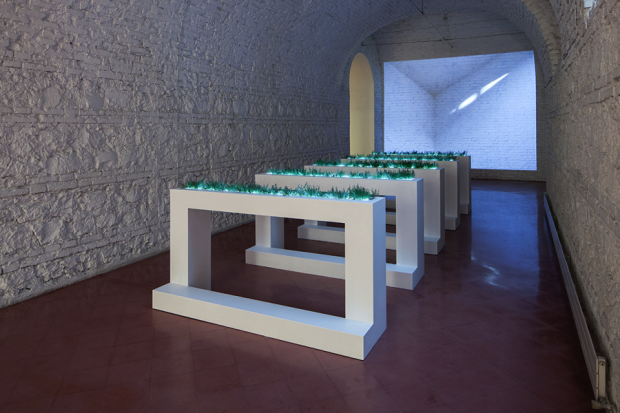LUMEN
An immersive interdisciplinary installation
Catherine Wagner, Artist
Thomas Kelley, Architect
Eric Nathan, Composer
Loretta Gargan, Landscape Architect

From the premiere installation of LUMEN for "Cinque Mostre: Time and Again” at the American Academy in Rome
On March 19, 2013 Pope Francis was inaugurated as the 266th Pope of the Catholic Church, signaling a crucial break from the weight of the past and an eye for a hopeful future. His first encyclical letter, Lumen Fidei (The Light of Faith), disseminated throughout the Catholic world, is infused with the overwhelming potential for humans to flourish during timorous times. He states with a modicum of severity, “[I]n the absence of light everything becomes confused; it is impossible to tell good from evil, or the road to our destination from other roads which take us in endless circles, going nowhere.”[1]
Inspired by the new Pope’s affinity for light as a metaphor for change, LUMEN aims to abstract and re-contextualize an act of spiritual contemplation. Driven by a secular regard for the Pope’s palpable sense of hope, renewal, and greater acceptance of outsiders, the installation sited in the Cryptoporticus at the American Academy in Rome incorporates a minimalist redesign of the pew, a long bench with a prayer stand typically used in a church for seating a collective. As a multimedia installation, the rows of white pews are planted with beds of thyme that invite the viewer to participate in an multisensory installation. These multiple elements are coupled with a musical score choreographed to play in dialogue with the projection of shifting light.
Upon entering the Cryptoporticus the procession begins. The white of the painted brick walls establishes a visual corridor remnant of a single-point perspective. The rows of sleek white pews, topped with thyme, glow and enliven the space to create a conversation between two and three dimensions. Looking further, the viewer’s eyes track a video of moving light as sound initiates the immersive experience. Each element of LUMEN functions individually and as part of the larger whole. Like the congregation of persons who come together to bear witness at an event, the parts sing as a group.
The minimalist design of the pew recalls the monumental shift in art, philosophy, and consciousness exemplified by modernist artists such as Donald Judd. The original design placed emphasis on several factors that include posture, close attention, and orientation towards an object-relic. Taking a utilitarian approach to form and finish, the redesigned pew’s standard elements are at once familiar and not. The traditional time worn wood of the bench that is etched in our collective memory is now given over to a pure white lacquer finish that transcends the patina of time and brings the sculpture into a contemporary context. Form and function establish the objecthood of this elegant icon, while the remembrance sparked by familiarity initiates connection to inner spirituality. While the pew remains iconic in scale and orientation, it no longer demands the observer to acknowledge any singular belief, but rather commences a new and open contemplation.
To deepen the experience, the prayer stand of the pew has been replaced with a thyme garden that initiates the first act of the immersive environment: smell. As memory is most deeply recalled through the olfactory sense, the scent of this herb is one that transcends time. As Marina Heilmeyer, author of Ancient Herbs, recounts, “What truly mattered in antiquity, however, was the scent of thyme rising from altars to please the gods. The intensity of this aroma, heightened by burning, may also account for its name, because the Greek word thymon refers not only to this plant but also to heart, flame, vital energy, passion, and smoke.”[2]
The video is a six-minute meditative loop of gradually shiftng light. The camera remains absolutely motionless as a slight, illuminated line maps where two walls meet. It comes together; it separates; it vanishes only to reappear anew. The ceiling of the room can be seen as an almost-black joint forming a room that appears to be at once approaching and receding. The slightest shift of magnitude in the band of light throws the room jumping between shades of gray. As this band moves back and forth, the grays of the walls seem to react in their own volition, flowing between deep, cool and light hues. The pacing is hypnotic on a level akin to watching the sun rise or set; one cannot look away. Like that ritual of the constancy of the Earth’s rotation, we are reminded of the permanence of light. In the last seconds, as the source of illumination closes with comparative rapidity, something unexpected happens in the wake of the receding light: the room begins to brighten. The deep shadows that were cast in the wake of the blast of light soften and give way to a glow as the last hint of brightness flits in a line.
The accompanying composition brings to the installation a haunting suite of strings and ambient shifts that aims to invite the viewer to become a participatory member engaged through mind and spirit. Listening to the light slide back and forth is at once both calming and exhilarating—sitting through multiple loop-cycles, one cannot help but create narratives guided by mystery and change. The unknown is presented, explored, and left for perpetual contemplation by the viewer.
LUMEN presents an invitation: to share in a space that transcends history and physicality. The vast experiential differences between this installation and the rites it draws upon are left to the participant. The interaction between the viewer and the installation begs contemplation without the imposition of a specified authority. Through an interdisciplinary approach to installation, LUMEN revaluates contemporary spirituality in the production of culture.
—Peter Cochrane
[2] Marina Heilmeyer from Ancient Herbs. The J. Paul Getty Museum, 2007.
